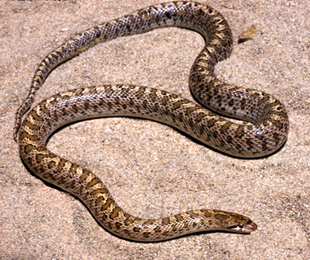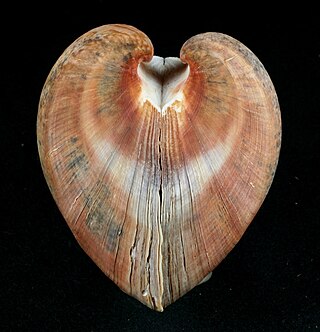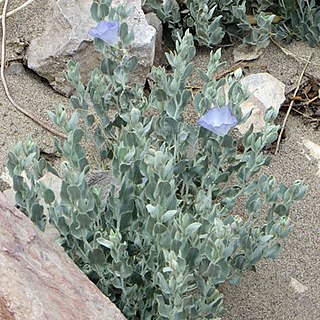
Caenorhabditis elegans is a free-living transparent nematode about 1 mm in length that lives in temperate soil environments. It is the type species of its genus. The name is a blend of the Greek caeno- (recent), rhabditis (rod-like) and Latin elegans (elegant). In 1900, Maupas initially named it Rhabditides elegans. Osche placed it in the subgenus Caenorhabditis in 1952, and in 1955, Dougherty raised Caenorhabditis to the status of genus.

The elegant tern is a tern in the family Laridae. It breeds on the Pacific coasts of the southern United States and Mexico and winters south to Peru, Ecuador and Chile.

Howard Robert Horvitz ForMemRS NAS AAA&S APS NAM is an American biologist best known for his research on the nematode worm Caenorhabditis elegans, for which he was awarded the 2002 Nobel Prize in Physiology or Medicine, together with Sydney Brenner and John E. Sulston, whose "seminal discoveries concerning the genetic regulation of organ development and programmed cell death" were "important for medical research and have shed new light on the pathogenesis of many diseases".

Sir John Edward Sulston was a British biologist and academic who won the Nobel Prize in Physiology or Medicine for his work on the cell lineage and genome of the worm Caenorhabditis elegans in 2002 with his colleagues Sydney Brenner and Robert Horvitz. He was a leader in human genome research and Chair of the Institute for Science, Ethics and Innovation at the University of Manchester. Sulston was in favour of science in the public interest, such as free public access of scientific information and against the patenting of genes and the privatisation of genetic technologies.

Arizona elegans is a species of medium-sized colubrid snake commonly referred to as the glossy snake or the faded snake, which is endemic to the southwestern United States and Mexico. It has several subspecies. Some have recommended that A. elegans occidentalis be granted full species status.

The Lake Wales Ridge National Wildlife Refuge is part of the United States National Wildlife Refuge (NWR) System, located in four separated areas on the Lake Wales Ridge east of US 27 between Davenport and Sebring Florida. The 1,194 acre (4.8 km2) refuge was established in 1990, to protect a host of plants and animals. It is also the first to be designated primarily for the preservation of endangered plants, and is not open to the general public. It contains a high proportion of remaining Florida scrub habitat. It is administered as part of the Merritt Island National Wildlife Refuge.

Bonamia menziesii, commonly known as Hawaiʻi lady's nightcap, is a species of flowering plant in the morning glory family, Convolvulaceae, that is endemic to Hawaii. It is a vine or twisting liana with branches that can reach 10 m (33 ft) in length. Hawaiʻi lady's nightcap inhabits steep slopes and level ground in dry, coastal mesic, mixed mesic, and, sometimes, wet forests at elevations of 150–625 m (492–2,051 ft).

Bonamia is a genus of the flowering plant family Convolvulaceae, commonly known as the bindweed family and named after the French physician and botanist François Bonamy (1710-1786). Members of the genus are commonly known as the lady's nightcap.

The false ark shells (Cucullaea) are a small genus of marine bivalve molluscs related to the ark clams. The genus is the only member of the family Cucullaeidae.

Martin Lee Chalfie is an American scientist. He is University Professor at Columbia University. He shared the 2008 Nobel Prize in Chemistry along with Osamu Shimomura and Roger Y. Tsien "for the discovery and development of the green fluorescent protein, GFP". He holds a PhD in neurobiology from Harvard University.

The dredge oyster, bluff oyster or Chilean oyster, is also known in Chile as ostra verde, is a species of bivalve mollusc in the family Ostreidae.

Naso elegans is a tropical fish found in coral reefs in the Indian Ocean. It is commonly known as the elegant unicornfish, Indian orange-spine unicorn, orange-spine unicorn, and smoothheaded unicornfish.

The elegant moray, or Goldsborough's moray eel, is a moray eel found in coral reefs in the Pacific and Indian Oceans. It was first named by Bliss in 1883.
Bonamia ostreae is a parasitic Rhizaria in the phylum Haplosporidia that can cause lethal infections in shellfish, particularly the European flat oyster, Ostrea edulis. Infection in oysters rarely results in clinical signs of disease and often the only indication of the infection is increased mortality. The Australian flat oyster, Ostrea angasi, has been infected with two similar Bonamia parasites, Bonamia exitiosa and B. roughleyi.

Bonamia grandiflora is a rare species of flowering plant in the morning glory family known by the common names Florida lady's nightcap, Florida bonamia, and scrub morning glory. It is endemic to Central Florida, where there are about 100 known populations remaining, many of which are within the bounds of the Ocala National Forest. The plant has declined in recent decades primarily due to the development of its habitat, which is being converted to urban zones and citrus groves. This is the primary reason that the plant was federally listed as a threatened species in 1987.
B. grandiflora may refer to:

Bonamia ovalifolia is a species of flowering plant in the morning glory family known by the common name bigpod lady's nightcap. It is native to North America, where there are only two known occurrences. There is one each in Brewster County, Texas, and Coahuila on the opposite side of the Mexico–United States border.

Bauruemys is an extinct genus of turtles in the family Podocnemididae.
Bonamia is a genus of protists belonging to the family Haplosporiidae.















